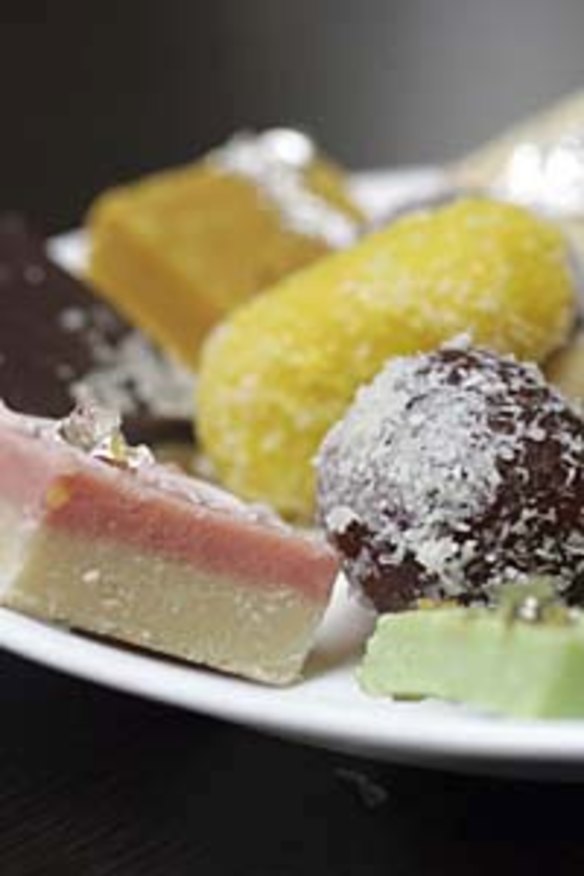Spice of Life

Indian
If size matters, this flashy Indian newcomer is sure to be a winner.
THE biggest Indian restaurant in Australia doesn't feel all that enormous. It may be deceptive, of course. Spice of Life is a new business in a long-standing, modern-bland, cement-rendered corner building at one end of a quaint row of weatherboard cottages in Harris Park.
Over the past few years this has become an increasingly active restaurant strip, populated mainly by Indian restaurants. But things move fast around here and food outlets come and go. Round the corner there's a shiny new Lebanese pastry shop and a newish Lebanese chicken takeaway.
Then there's Spice of Life (formerly Chutney), just three months old, featuring a giant striped balloon on the roof with “New” emblazoned on it and the bold claim of being the largest Indian restaurant in the land.
It's hard to judge. Inside the air-conditioned cool of the main dining area, with its dark wooden tables and light-coloured tiled floor, we notice lots of caramel wood and glass doors leading to other eating areas and imagine them heaving with Bollywood-style weddings and birthdays.
Today, a Sunday, there are mostly family groups with children and more balloons – tied to a stroller, or bobbing under the ceiling and being chased in vain by a small boy.
Lunch is what we're after, of course. The menu is dazzlingly long. Rather than specialise (as the earlier Harris Park Indian restaurants did) in milky, cardamom-scented sweets made on the premises and vegetarian snacks – often south Indian in style – this is a cover-all-bases kind of list.
Dishes range from decidedly north Indian kormas and vindaloos to tandoori, thalis and even pizza. There's lots of non-veg (as the Indians describe it), including goat, chicken and lamb, and a whole section of southern Indian vegetarian snacks with names such as dosa, idli and uttapam, made with pulses and rice flour.
Then there are the weekend specials or chaats – north Indian snacks made with things such as fried crackers, chickpeas, chopped onion and sweet-and-sour chutney. Behind us, bottles gleam above the bar. There's a whirring lassi cooler, a brightly coloured computer screen for registering meal orders and the mandatory television screen flashing Indian music videos.
We try to take a cue from the other lunchers – rangy students in jeans eating biryani and chicken tikka; middle-aged ladies in saris scooping up rice from thali platters; the family beside us sopping up curry gravy from copper balti dishes with baskets of ghee-glistening naan. And then there are the two young men by the window, tearing pieces from a giant, tube-like roll of crisped batter. A masala dosa. We hesitate no longer.
We start with a plate of papri chaat – crunchy, wheat-flour chips and fried-noodle lengths (known as sev) piled with diced potato, red onion and boiled chickpeas and drenched with yoghurt, tamarind and mint-green chutneys. The dish is a bit like an Indian version of nachos and it is equally moreish.
Our great big dosas are a little more nutritionally sound. These Indian savoury pancakes are made with a soured rice and lentil-flour batter and filled with turmeric-stained spiced potatoes flecked with dark lentils. They're good, although not as tangy as some, served with a tomatoey, chilli relish, a sweetish coconut chutney and a soupy, tamarind-tart sambhar (a lentil and vegetable broth) for dunking.
In an appropriately ecumenical spirit, we've also ordered methi chicken, creamy, rich and strongly flavoured with fenugreek (methi). The leftovers will make a great dinner for our butter-chicken-loving daughter.
We've been served somewhat sporadically by a rotation of well-meaning but often oblivious waiters, more engaged by the coloured panels of the automated ordering software than by customers wanting more iced water. At the sweets counter, I am more fortunate. The woman behind it is full of recommendations. She tells me the sweets are all made on the premises and puts together a box of barfi (condensed-milk and nut slices in various flavours and colours) for us to take home. I try one – with shreds of carrot – with a milky masala tea before we leave. It's predictably sweet but pleasantly textured, neither gooey nor crumbly, with a carroty, cardamom-perfumed mellowness.
After lunch we wander down Wigram Street, admiring the mix of sari outlets, accountancy firms and spice shops (Lebanese and Indian) that makes up the Harris Park streetscape. Many cottages have been turned into Indian restaurants, with similar menus to the one we've just eaten from but with mostly just one or two rooms. On a national level, we're still unsure. But in Harris Park, there's nowhere bigger than Spice of Life.
DIGEST
Food Good, all-Indian menu with some definite highlights.
Service Slightly awkward; still finding its feet, perhaps.
Atmosphere Convivial but, above all, serviceable.
Value Good: mains $11-$17, snacks $7-$15.
Noise Reasonable but a 200-person function could change that.
Recommended dishes Masala dosa (lentil and rice-flour pancake), papri chaat (fried wheat-flour chips with toppings), salt lassi (yoghurt drink) and selected barfi (Indian sweets).
Restaurant reviews, news and the hottest openings served to your inbox.
Sign up